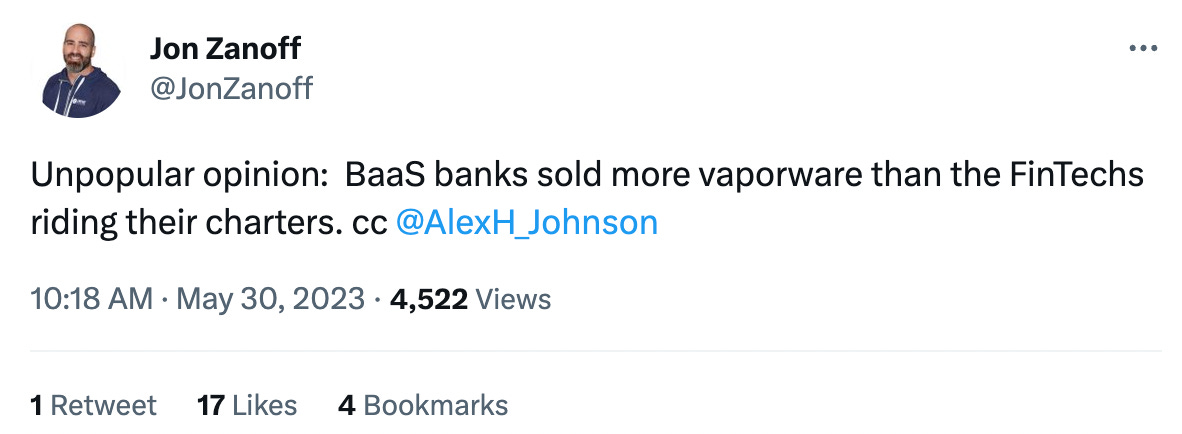Hi there,
How does one measure traction? This isn’t meant to be a trick question, but more often than not, it is.
Over the past few weeks, there’s been an uptick of news when it comes to neobanks. Some are being forced to close-up shop, others are gaining traction, and even a few hitting the scene with their first round of funding.
However it’s hard to deny the tenor has turned negative on digital banking, if not downright snarky.
Many thought-leaders have given their take on questions such as: What is the future of neobanks? Are depository accounts a business or feature? Is this just early innings, or are we in the bottom of the ninth?
The question I have, however, is:
Is the slew of seed/series A neobanks being measured on the right metrics in order to determine the viability of their business?
Paraphrasing the “neobank thesis”, the problem statement is as so: Consumers increasingly don’t trust the big, bad, evils of Wall Street. Challenger banks can acquire customers and earn trust faster (and cheaper!) by targeting specific – often underserved – affinity groups, while delivering a delightfully digital first, trustworthy, and tech-forward experience.
If we were to poll customers asking if their neobank delivered on these three things (☝️) I don’t doubt their answers would be, “Yes, yes, and yes.”
Unfortunately, these companies raised, at best, asinine valuations. Instead of being measured on leading indicators at seed such as value-add or even product-market fit proximity, the 2020-2021 cohort of neobanks are now being looked at solely based on the acquisition and revenue metrics of later-staged businesses.
I’ve touched on this before, but on average, it takes 7 to 10 years to know if a venture-backed company will be successful (excluding peak bubble; founders taking chips off the table out at A). When looking at neobanks, or consumer FinTech as a whole meeting their early demise, the lesson we can take-away is not whether or not the business was viable.
Do late-stage metrics of traction need some re-adjusting? No. But the hype of the past few years, accelerated by billion dollar seed funds and first-time angels, all but guaranteed failure. It’s incredibly important for founders and investors to not only align on valuation of the current round, but what achievable benchmarks will need to be hit to attract subsequent capital.
The good news? Digital banking is definitely in the early innings.
Cheers,
P.S. - The other side of the neobank coin: BaaS banks were also living in vaporware-land.
✍️ Empire Startups Contributor Model
Over a decade ago, Empire Startups began as a meetup community for those interested in this “thing” called FinTech. Today, our platform is host to individuals across North America, looking for the latest insights, news, trends, and events happening across this thriving industry.
We consider ourselves a platform that focuses on bringing diverse voices to the table and highlighting unique viewpoints. As our humble beginnings began directly from the startup ecosystem, we have a strong pulse on early-stage entrepreneurs, founders, investors, and enthusiasts.
This is a chance for writers and thought-leaders in the FinTech space to share their ideas and expertise with our ever-growing community and newsletter platform.
If interested in this opportunity, please reach out to our team here.
🎟 Featured FinTech Events
New York
Other Cities
Toronto
🗞 The latest news in FinTech.
Reads
💸 Nymbus lands $70M to help banks digitally transform | Techcrunch
Banks, unsurprisingly, are feeling the pressure to adapt to a changing world by modernizing and digitizing both their operations and products.
🧑⚖️ Why fintech and crypto companies are craving good regulation | Fast Company
Leaders in these industries agree that it is essential to foster rather than stifle innovation.
😬 Plastiq files for bankruptcy, inks deal with Priority | Axios
Plastiq was valued at $480 million in a now dead SPAC deal last year.
📈Klarna’s losses halve as Swedish fintech predicts return to profit | Financial Times
Klarna, the Swedish buy now, pay later fintech company, halved its net loss in the first quarter, recording a significant improvement in its bottom line after a major cost-cutting drive.
💳 Amex planning to use AI for ‘approving cards and lines of credit’ | Cointelegraph
AmEx sees opportunity to use these technologies to better improve its customer experience across its credit cards and bank offerings for businesses and individuals.
Listens
💰 What will payments be like in 2030? | The Money Pot
Embedded finance is providing tons of opportunities to reimagine payments. When it all becomes digital, the nature of payments has to be more mindful, and the decisions around processes are growing more deliberate.
Guest: Maria Prados, Head of Vertical Growth at Worldpay
🤖 Legal Implications of AI | Breaking Banks
With the profession digitizing to move faster and operate more efficiently, AI will have a significant impact from automation of legal functions to smart contracts. Listen as they cover the broken business model of legal services, the political and regulatory barriers to change and the transformative potential of legal tech.
🚀 Featured FinTech Funding
PRE-SEED
Unplex, $100K (Money Transfer/Remittances ,Chicago)
Plenty, $2.75M (Wealth Management, Atlanta)
SEED
Onyx Private, $4.1M (Digital Banking, Miami)
SERIES A
Pesto, $11M (Lending, San Francisco)
SERIES D
OpenFin, $35M (Core Technology, New York)
NYMBUS, $70M (Core Technology, Jacksonville)
💼 Featured FinTech Jobs
New York
Sr. Engineering Manager - AI & Search Platform, AlphaSense
AI Engineer 2023-5-24, Kasisto
Growth Marketing Manager, Canoe
Director, Investment Operations, Equi
Remote
Engineering Manager, Gradient A.I.
Impounds Supervisor, Lendbuzz
Senior Product Marketing Manager (Remote), Routable
Director of Product Management, Forge
San Francisco
Senior Manager Financial Crimes, Jiko
Full Stack Software Engineer Workplace, Veem
Workplace Manager, Veem
Enterprise Technical Account Manager, Plaid













